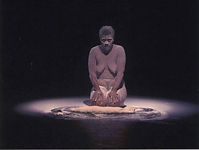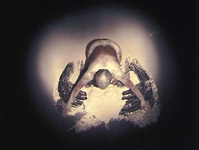Just recently I came across the performance work of the artist Bernie Searle, who is born in South Africa, and meanwhile also lives and works in New York. I had the chance to see a split screen video projection of ‘snow white‘ – like I tried to imitate it with the images below – in full length. The rest of the information collected and presented here has been accumulated across the internet, and as much I would like to have the chance to see Bernie Searle’s performance once in persona, I fully understand and can agree to her interpretation of the intertwinement of performative and the representational aspects.
Though for the rest of this post I give space to her own words, as well to some essay excerpts by Liese van der Watt on earlier works of Bernie Searle and incorporated identity issues:


imgs ‘snow white’ Bernie Searle / Gallery michael stevenson
excerpt: Rory Bester, ‘Interview with Berni Searle for The Field’s Edge’ …
Bernie Searle: My works have a definite performative character to the extent that they invoke movement and indeterminancy. But there is an assumption that because it’s performative, I perform. I have been asked on a number of occasions to do performances. The problem with ‘performing’ is that I am more directly and easily consumed or exoticised, which I’m trying to avoid. Mediating the ‘performance’ through lens-based media provides me with options to reconstruct myself in the process. Ana Mendieta describes the ‘performative’ as actions that are derived from and located within a grid of power relations. It’s not just artistic but something that is more embedded in everyday life and culture. This sums up the significant potential of the ‘performative’ for me.
.. and to continue with the corresponding interpretation of her work by Liese van der Watt, even though she describes here in length the very different work ‘Traces‘:
Yet it is a point of contact that also consumes her. Her ancestry provides an anchor, yet it weighs her down, as in another work, Looking back, where spices seems to enter every possible orifice, as she lies silently suffocating in the invasive powder. There is a paradox of course, the weight of powder cannot be much, yet it oppresses her, an indication that even tenuous links may become determining in the greedy politics of claiming identities. Hence, in Traces Searle stages an escape, we witness the trace of her bodily flight, yet she returns again and again to that invasive weight.
On the whole then, neither her absence nor presence seems final in Traces: the body present bespeaks disappearance as it is smothered and suffocated by the spices covering it, and the body absent is very much still present in the outlines left in the spiced powders. The body moves between absence and presence, never still, it appears and disappears. The multiple selves, situated in continual movement between appearance and disappearance, invoke ideas of reinventing the self over and again. These photographs simultaneously underwrite stasis and movement, liminality and legibility – they are a dialectic between presence and absence and between coming and going.
This play with invisibility becomes a politics of sorts in the way that performance scholar Peggy Phelan employs the concept when she advocates the power of remaining invisible – unmarked – rather than visible, because through visible representation “contemporary culture finds a way to name and thus to arrest and fix the image of that other.”(1993:2) Phelan is suspicious of the political power traditionally assigned to the domain of the visible and to visibility politics and we may argue that Searle shares this suspicion in works that always posit the marked against the unmarked. Searle’s strategy of in/visibility enacts her /our struggle for identity by being never completely anywhere. Her form is always changing, hovering between appearance and erasure.
… (link)
